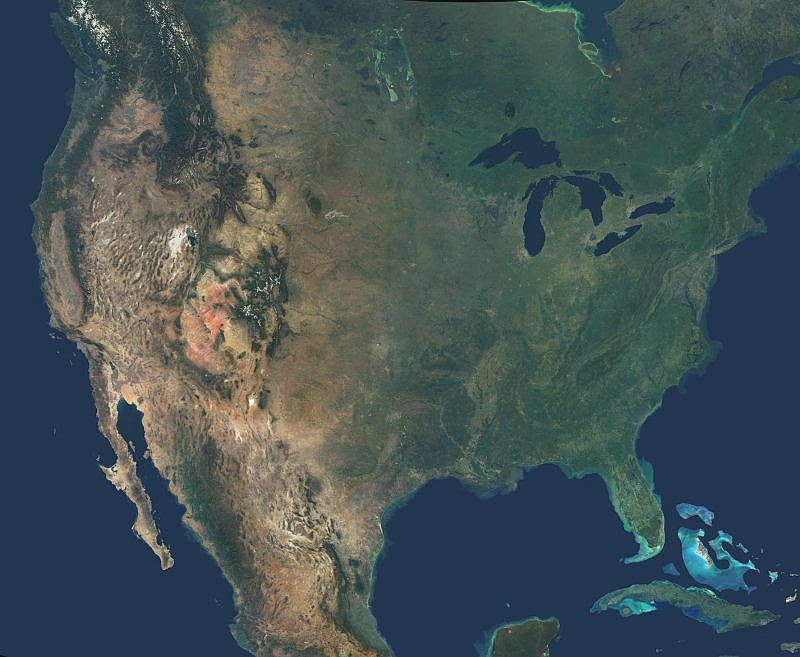The tapestry of North America unfurls beneath an ethereal dome, revealing stunning layers of geography, climate, and biodiversity, as seen from a satellite perspective. This celestial vantage point serves as a cartographic canvas, a luminous portrayal of the continent’s rich ecological narrative. The North American satellite map, a marriage of technology and artistry, invites us to explore its extraordinary features—colorful topographies, intricate ecosystems, and sprawling urban landscapes—all interwoven with the delicate threads of climate change.
Imagine North America as a vast, tumultuous ocean, where mountains rise like islands above the surface, forests cascade like verdant waves, and cities pulse with the frenetic energy of life. From this lofty perspective, it becomes evident that this continent is not merely a collection of geographical boundaries; it is an eloquent manifestation of the planet’s ecological soul. The satellite image acts as an artistic lens, framing North America’s unparalleled allure in a single glance.
Geographically, North America is an intricate mosaic composed of diverse ecosystems, each with its distinctive personality. The sweeping plains of the Midwest, the arid deserts of the Southwest, and the dense, temperate rainforests of the Pacific Northwest can all be discerned with remarkable clarity. From a bird’s-eye view, one might see the Great Lakes shimmering like sapphires amidst the green and brown expanses of agricultural fields and forested regions.
In the northern reaches, the Arctic tundra exists like a fragile shroud, its icy blanket a stark reminder of the harsh beauty of nature. Here, climate change paints its spectral touch. As the satellite map reveals the encroaching thaw, it serves as a haunting metaphor for warming temperatures, the bleached bones of polar bears narrating a tale of survival against the odds. The transition zones—where different biomes merge—accentuate the urgent need for environmental stewardship in light of these changing landscapes.
Furthermore, the Appalachian and Rocky Mountain ranges are visible, resembling the backbone of the continent. These geological marvels, forged over millions of years, stand as sentinels, reminding us of the power of natural forces. Yet, amidst their grandeur, the satellite map exposes the scars of human intervention—deforestation, mining, and urban sprawl etching their marks upon the earth’s surface. Each scar is a testament to choices made and consequences faced, reiterating the necessity for sustainable practices.
The urban landscapes, blips of civilization scattered interstitially across the expanse, unveil a striking juxtaposition. Cities from New York to Los Angeles emerge as vibrant constellations of human ingenuity and ambition. As satellites capture their sprawling grids and intricate networks of roads, they epitomize innovation and progress. Yet, they also reflect the complexities of resource consumption and waste generation, reminding us of the ecological footprint left behind in the quest for development.
The phenomenon of climate change looms large over these intricate maps. Temperature gradients, shifting weather patterns, and natural disasters present themselves dramatically through color-coded representations across the continent. For example, the increasing frequency of hurricanes along the Gulf Coast sends ripples of alarm through the underwater realms, where marine biodiversity teeters on the brink. The satellite imagery encapsulates more than mere surface observations; it encapsulates humanity’s dual role as a steward and destroyer of the natural world.
Moreover, an exploration into North America’s coastal zones reveals a heartbreaking narrative. The beautiful shorelines, containing delicate ecosystems like mangroves and coral reefs, appear frayed and vulnerable. From above, the encroaching tides of climate change become undeniably evident, foreshadowing an uncertain future. The metaphorical wave of rising sea levels serves as a clarion call, highlighting the urgency for immediate action.
As one dives deeper into the satellite map’s layers, the stories of indigenous lands begin to surface. Native American territories, steeped in ancestral wisdom, highlight the accord between humans and nature—an invaluable lesson that modern society, with its frenetic pace, often overlooks. These lands, rich in biodiversity and cultural heritage, remind us of a time when humanity thrived in harmony with the environment. Their presence in the satellite imagery offers a lens through which to re-envision sustainable paradigms that honor both the earth and its original stewards.
The ecological intricacies revealed through North America’s satellite map beckon solemn reflection on the interconnectivity between climate, geography, and human influence. The canvas of this satellite imagery speaks a language that transcends words—a visual lexicon that implores us to reckon with our role in shaping the fate of this continent. It encapsulates both the beauty of what has been and the fragility of what remains.
In conclusion, the North American satellite map is more than a mere geographical representation; it is a poignant narrative of ecological evolution and an urgent missive regarding the need for vigilance and proactive stewardship. It challenges us to embrace the responsibility we hold over our environment. While the map may depict the splendor of what exists, it simultaneously encourages a deeper inquiry into how we can protect, preserve, and restore the invaluable ecosystems that define this magnificent continent. Taking heed of this visual testimony, we are called to foster a connection with nature that transcends the artificial constructs of modern life—a commitment that is crucial if we are to safeguard the planet for future generations.
